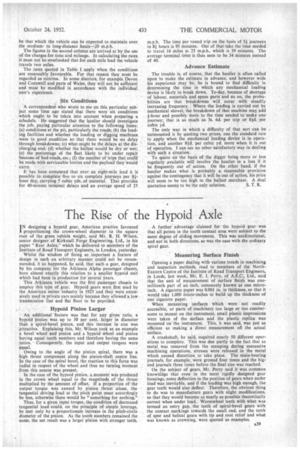The Rise of the Hypoid Axle
Page 57

If you've noticed an error in this article please click here to report it so we can fix it.
IN designing a hypoid gear, American practice favoured 1. proportioning the crown-wheel diameter to the square root of the gross vehicle weight, said Mr. R. H. Wilson. senior designer of Kirkstail Forge Engineering, Ltd., in his paper "Rear Axles," which he delivered to members of the Institute of Road Transport Engineers, in London, yesterday.
Whilst the wisdom of fixing so important a feature of design in such an arbitrary manner could not be recommended, it so happened, be said, that such a gear, designed by his company for the Atkinson Alpha passenger chassis, bore almost exactly this relation to a smaller hypoid unit which had been in productiort foT several years.
This Atkinson vehicle was the first passenger chassis to employ this type of gear. Hypoid gears were. first used by the American motor industry in 1925 and they were extensively used in private cars mainly because. they allowed a low transmission line and flat floor to be provided.
Hypoid Pinion Larger
An additional' feature was that for any given ratio, a hypoid pinion was up to 30 per cent. larger in diameter than a spiral-bevel pinion, and this increase in size was attractive. Explaining this, Mr. Wilson took as an example a bevel wheel and pinion and a hypoid wheel and pinion having equal tooth numbers and therefore having the same ratios. Consequently, the input and output torques were equal.
Owing to the angle of the pinion spiral, there was a high thrust component along the pinion-shaft centre line. in the case of the spiral bevel, the reaction to this force was radial in respect of the wheel and thus no turning moment .from this source was present.
In the case of the hypoid pinion, a.moment was produced in the crown wheel equal to the magnitude of the thrust multiplied by the amount of offset. If a proportion of the output torque was caused by pinion thrust alone, the tangential driving load at the pitch point must accordingly be less, otherwise there would he "something for nothing."
Thus, for a given input torque, the condition of decreased tangential load could, on the principle of simple leverage, be met only by a proportionate increase in the pitch-circle diameter of the pinion. As the tooth numbers remained the same, the net result was a larger pinion with.stronger teeth.
A further advantage claimed for the hypoid gear was that all points in the tooth contact area were subject to the same degree of sliding movement. This was unidirectional, and not in both directions, as was the case with the ordinary spiral gear.
Measuring Surface Finish
Opening a paper dealing with various trends in machining and inspection methods, read to members of the NorthEastern Centre of the Institute of Road Transport Engineers, in Leeds, last week, Mr. E. I. Perry, of A.E.C., Ltd., said that the unit of measurement of surface finish was onemillionth part of an inch, commonly known as one microinch. A cigarette paper was 0.001 in, in thickness, so that it would take 1,000 micro-inches to build up the thickness of one cigarette paper.
When measuring surfaces which were not readily accessible, or parts of machinery too large or too cumbersome to mount on the instrument, small plastic impressions were taken of the surface and the plastic replica was mounted on the instrument. This, it was said, was just as efficient as making a direct measurement ofl the actual surface.
A crankshaft, he said, required nearly 50 different operations to complete. This was due partly to the fact that as metal was removed from the stamping during successive machining operations, stresses were released in the metal which caused distortion_ to take place. The main-hearing journals, for example, were ground four times and the bigend journals three times before the final size was reached.
On the subject of gears, Mr. Perry said it was common knowledge that even in the most rigidly designed gear housings, some deflection in the position of gears when under load was inevitable, and if the loading was high enough, the gear teeth would also deflect. Therefore, the obvious thing to do was to manufacture gears with slight modifications, so that they would become as nearly as possible theoretically correct when under load. Wormwheel teeth with what was termed an entry gap, the teeth of spiral-bevel gears with the contact markings towards the small end, and the teeth of spur and helical gears with tip and root relief and what was known as crowning, were quoted as examples,




















































































